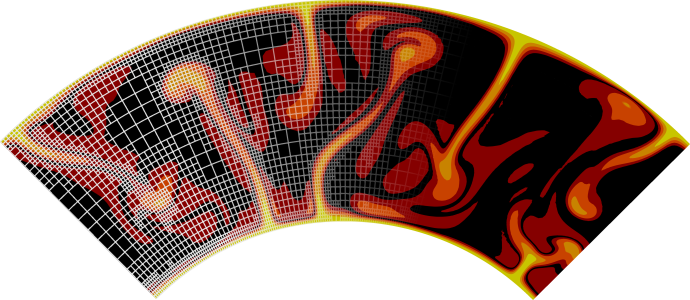Prescribed velocity boundary conditions#
Most of the time, one chooses relatively simple boundary values for the velocity: either a zero boundary velocity, a tangential flow model in which the tangential velocity is unspecified but the normal velocity is zero at the boundary, or one in which all components of the velocity are unspecified (i.e., for example, an outflow or inflow condition where the total stress in the fluid is assumed to be zero). However, sometimes we want to choose a velocity model in which the velocity on the boundary equals some prescribed value. A typical example is one in which plate velocities are known, for example their current values or historical reconstructions. In that case, one needs a model in which one needs to be able to evaluate the velocity at individual points at the boundary. This can be implemented via plugins.
To implement a new boundary velocity model, you need to overload the
aspect::VelocityBoundaryConditions::Interface
class and use the
ASPECT_REGISTER_VELOCITY_BOUNDARY_CONDITIONS macro to register your new
class. The implementation of the new class should be in namespace
aspect::VelocityBoundaryConditions.
Specifically, your new class needs to implement the following basic interface:
template <int dim>
class aspect::VelocityBoundaryConditions::Interface
{
public:
virtual
Tensor<1,dim>
boundary_velocity (const Point<dim> &position) const = 0;
virtual
void
initialize (const GeometryModel::Interface<dim> &geometry_model);
virtual
void
update ();
static
void
declare_parameters (ParameterHandler &prm);
virtual
void
parse_parameters (ParameterHandler &prm);
};
The first of these functions needs to provide the velocity at the given point.
The next two are other member functions that can (but need not) be overloaded
if a model wants to do initialization steps at the beginning of the program or
at the beginning of each time step. Examples are models that need to call an
external program to obtain plate velocities for the current time, or from
historical records, in which case it is far cheaper to do so only once at the
beginning of the time step than for every boundary point separately. See, for
example, the aspect::VelocityBoundaryConditions::GPlates class.
The remaining functions are obvious, and are also discussed in the documentation of this interface class at aspect::VelocityBoundaryConditions::Interface. The purpose of the last two functions has been discussed in the general overview of plugins above.

